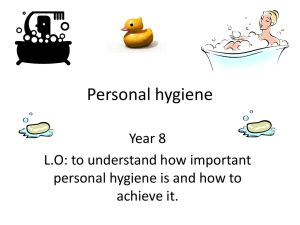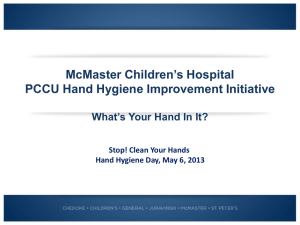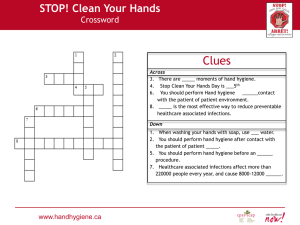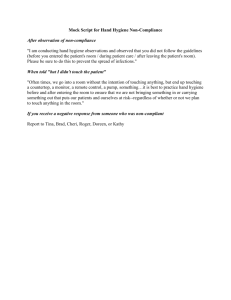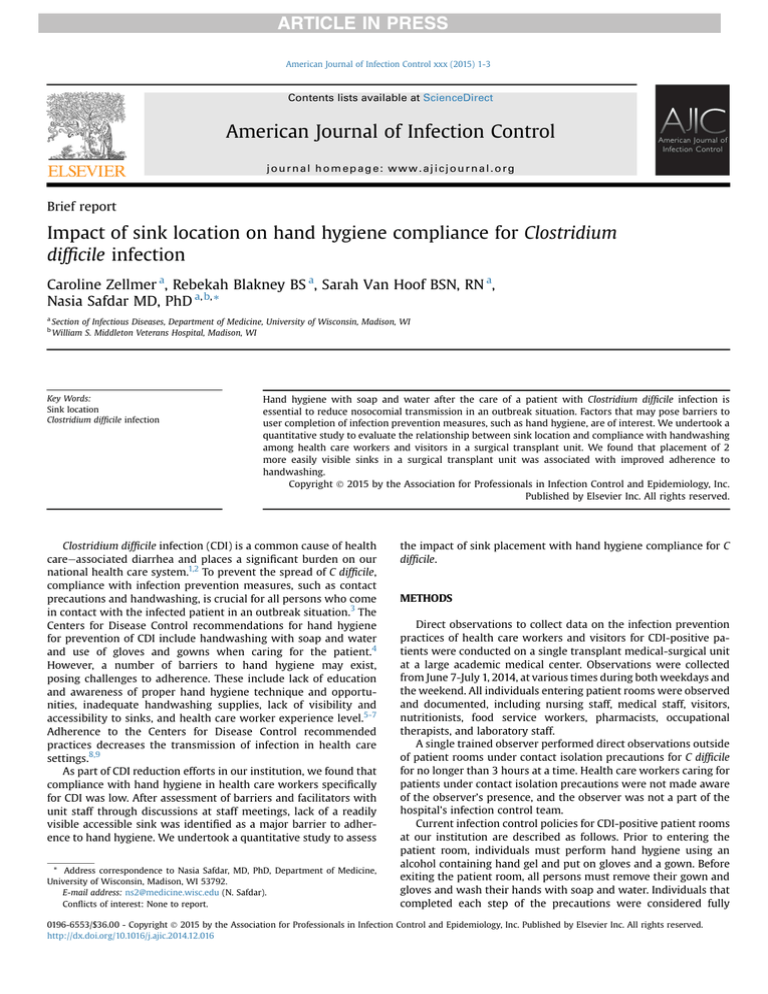
American Journal of Infection Control xxx (2015) 1-3
Contents lists available at ScienceDirect
American Journal of Infection Control
American Journal of
Infection Control
journal homepage: www.ajicjournal.org
Brief report
Impact of sink location on hand hygiene compliance for Clostridium
difficile infection
Caroline Zellmer a, Rebekah Blakney BS a, Sarah Van Hoof BSN, RN a,
Nasia Safdar MD, PhD a, b, *
a
b
Section of Infectious Diseases, Department of Medicine, University of Wisconsin, Madison, WI
William S. Middleton Veterans Hospital, Madison, WI
Key Words:
Sink location
Clostridium difficile infection
Hand hygiene with soap and water after the care of a patient with Clostridium difficile infection is
essential to reduce nosocomial transmission in an outbreak situation. Factors that may pose barriers to
user completion of infection prevention measures, such as hand hygiene, are of interest. We undertook a
quantitative study to evaluate the relationship between sink location and compliance with handwashing
among health care workers and visitors in a surgical transplant unit. We found that placement of 2
more easily visible sinks in a surgical transplant unit was associated with improved adherence to
handwashing.
Copyright Ó 2015 by the Association for Professionals in Infection Control and Epidemiology, Inc.
Published by Elsevier Inc. All rights reserved.
Clostridium difficile infection (CDI) is a common cause of health
careeassociated diarrhea and places a significant burden on our
national health care system.1,2 To prevent the spread of C difficile,
compliance with infection prevention measures, such as contact
precautions and handwashing, is crucial for all persons who come
in contact with the infected patient in an outbreak situation.3 The
Centers for Disease Control recommendations for hand hygiene
for prevention of CDI include handwashing with soap and water
and use of gloves and gowns when caring for the patient.4
However, a number of barriers to hand hygiene may exist,
posing challenges to adherence. These include lack of education
and awareness of proper hand hygiene technique and opportunities, inadequate handwashing supplies, lack of visibility and
accessibility to sinks, and health care worker experience level.5-7
Adherence to the Centers for Disease Control recommended
practices decreases the transmission of infection in health care
settings.8,9
As part of CDI reduction efforts in our institution, we found that
compliance with hand hygiene in health care workers specifically
for CDI was low. After assessment of barriers and facilitators with
unit staff through discussions at staff meetings, lack of a readily
visible accessible sink was identified as a major barrier to adherence to hand hygiene. We undertook a quantitative study to assess
* Address correspondence to Nasia Safdar, MD, PhD, Department of Medicine,
University of Wisconsin, Madison, WI 53792.
E-mail address: ns2@medicine.wisc.edu (N. Safdar).
Conflicts of interest: None to report.
the impact of sink placement with hand hygiene compliance for C
difficile.
METHODS
Direct observations to collect data on the infection prevention
practices of health care workers and visitors for CDI-positive patients were conducted on a single transplant medical-surgical unit
at a large academic medical center. Observations were collected
from June 7-July 1, 2014, at various times during both weekdays and
the weekend. All individuals entering patient rooms were observed
and documented, including nursing staff, medical staff, visitors,
nutritionists, food service workers, pharmacists, occupational
therapists, and laboratory staff.
A single trained observer performed direct observations outside
of patient rooms under contact isolation precautions for C difficile
for no longer than 3 hours at a time. Health care workers caring for
patients under contact isolation precautions were not made aware
of the observer’s presence, and the observer was not a part of the
hospital’s infection control team.
Current infection control policies for CDI-positive patient rooms
at our institution are described as follows. Prior to entering the
patient room, individuals must perform hand hygiene using an
alcohol containing hand gel and put on gloves and a gown. Before
exiting the patient room, all persons must remove their gown and
gloves and wash their hands with soap and water. Individuals that
completed each step of the precautions were considered fully
0196-6553/$36.00 - Copyright Ó 2015 by the Association for Professionals in Infection Control and Epidemiology, Inc. Published by Elsevier Inc. All rights reserved.
http://dx.doi.org/10.1016/j.ajic.2014.12.016
2
C. Zellmer et al. / American Journal of Infection Control xxx (2015) 1-3
compliant. If an individual failed to complete each step of the
isolation precautions they were considered to be noncompliant. An
individual was considered partially compliant if they completed
some, but not all of the contact isolation precaution protocol. As
part of the assessment of barriers and facilitators of hand hygiene, it
became apparent that health care workers were not using the sink
inside the patient room because of clutter, lack of hands-free foot
pedals, and concern that the faucet handles may be contaminated
with C difficile spores. Therefore, the usual practice was to remove
personal protective equipment inside the room but perform hand
hygiene with soap and water outside the patient room. Subsequently, the observer was instructed to conduct observations
outside the room on exit.
Time was measured for each component of the contact isolation
precautions. Time before was considered as the time taken to put
on gloves and a gown and perform hand hygiene prior to entering
the patient room. Time in the room was counted as the time that an
individual spent in the patient room prior to removing any personal
protective equipment or performing hand hygiene. Time after
included the removal of gowns and gloves and completion of hand
hygiene on exiting the patient room.
Although there were 36 sinks on the unit before our intervention, all but 2 of them were in the patient rooms. Each patient room
had a sink, but it was not used by health care workers because of
patient clutter, lack of access because of the presence of furniture,
or general unfamiliarity with the patient room layout. There have
many institutional initiatives over the years to reduce clutter in
patient rooms; however, these have not been successful. In the unit
under study, a transplant patient’s length of stay is >7 days;
therefore, it remains difficult to minimize clutter around the
existing sinks. The 2 hallway sinks were located at the end of the
hallways and were not readily visible from most patient rooms.
Subsequently, 2 additional sinks were placed in highly visible
locations on the unit. These sinks included foot pedals for ease
of use and convenience. Each sink was equipped with proper and
adequate supplies for handwashing. The location of the sinks
was chosen after walk rounds were conducted with engineering,
facilities planning, infection control, and unit staff to determine the
optimal locations for sink placement based on workflow. Postintervention, the observations were conducted after the sinks had
been in place for 6 months. The time periods observed before and
after were approximately the same, pre- and postimplementation.
A pooled t test was used for testing differences in time proportions. Contact isolation precaution compliance was analyzed
using a c2 test. P value <.05 was the threshold for statistical significance. SAS software (Cary, NC) was used for statistical analysis.
RESULTS
There were 69 total observations made in the course of our
study. Individuals observed included 28 nursing staff, 19 medical
staff, 9 visitors, 2 nutritionists, 4 food service staff, 4 pharmacists,
2 occupational therapists, and 1 laboratory staff. Compliance with
hand hygiene and contact precautions before and after sink
placement is shown in Table 1.
Overall, contact precaution compliance increased 22% after the
intervention, from 13% to 35% (P ¼ .001). The proportion of noncompliant individuals did not change because both pre- and postintervention, 30% of individuals observed failed to be compliant
with every component of the isolation contact precautions. The
number of individuals who were partially compliant reduced from
57% to 35%.
Completion of proper hand hygiene on exiting the CDI patient
room improved by 18% with the addition of the 2 new visible sinks
(P ¼ .03). The number of individuals who failed to perform any hand
Table 1
Relationship between compliance with hand hygiene and contact precautions and
sink placement
Compliance
No HH before
Indeterminate HH before
Alcohol gel before
No HH after
Indeterminate HH after
Alcohol gel after
Soap and water after
Fully compliant
Partially compliant
No compliance
Gown worn
Gloves worn
Preintervention
72.5
7.45
27.5
54.6
16.3
11.7
33.8
13.2
56.0
30.8
57.1
58.2
(58/80)
(12/92)
(22/80)
(42/77)
(15/92)
(9/77)
(26/77)
(12/91)
(51/91)
(28/91)
(52/91)
(53/91)
Postintervention
51.6
10.1
48.4
37.1
10.1
11.3
51.6
34.9
34.8
30.4
60.9
62.3
(32/62)
(7/69)
(30/62)
(23/62)
(7/69)
(7/62)
(32/62)
(24/69)
(24/69)
(21/69)
(42/69)
(43/69)
P value
.0104*
.5727
.0104*
.0404*
.2602
.9417
.0339*
.0012*
.0076*
.9637
.6353
.6021
NOTE. Values are % (n/N).
HH, hand hygiene.
*Significant at a ¼ 0.05.
hygiene after being in a CDI patient room decreased from 54% to
37% (P ¼ .04). After the intervention, the number of individuals who
performed proper hand hygiene prior to entering the patient room
increased by 19% (P ¼ .01). The percentage of individuals who failed
to perform any hand hygiene before entering the patient room was
reduced by 21% (P ¼ .01). The distance of the sinks from the central
nurse’s station was 9.98 meters for one sink and 2.27 meters for the
other. The sink closer to the nurses station was within easy range of
most of the patient rooms and was the one that was the more
heavily used.
On average, the time taken by individuals prior to entering the
CDI patient room increased by 22 seconds because of the increased
incidence of bundled activities. The average amount of time spent
in the patient room increased by 1.32 minutes. The time taken to
remove gloves and a gown and to perform hand hygiene after
interacting with a CDI-positive patient did not change after the
intervention (Table 2).
Feedback from staff showed a high level of satisfaction, and they
reported that the 2 new visible sinks enhanced the likelihood of
completing proper hand hygiene on exiting the patient room.
DISCUSSION
In our study we found that the placement of additional sinks in a
visible and easily accessible location increased the performance
rate of proper hand hygiene on exiting a CDI-positive patient room.
Additionally, fewer individuals chose to use alcohol gel after leaving
a CDI room. This may have been the result of the placement of
additional sinks on the unit where observations were conducted.
Previously, no easily visible sinks were available for immediate use
on exiting patient rooms, and health care workers would need to
walk to another part of the unit to find a sink. This may have created
inconvenience and a systems barrier for visitors and health care
workers unfamiliar with the unit.
It is important to consider our conclusions within the confines of
our study, which has limitations. All observations and data collection were completed by a sole individual. A Hawthorne effect is
Table 2
Relationship between time taken to perform a task and when the intervention took
place
Activity
Time before room entry (s)
Time in room (s)
Time after room exit (s)
Preintervention
Postintervention
P value
38.1
424
26.1
60.8
493
26.1
.1220
.6485
.9965
C. Zellmer et al. / American Journal of Infection Control xxx (2015) 1-3
very likely, which could have resulted in an overestimation of hand
hygiene compliance rates.10 Additionally, the scope of our study is
limited to a single unit with relatively few observations. However,
the intervention was undertaken in the setting of a CDI cluster,
and a rapid quality improvement process was initiated. Other interventions undertaken at the same time, such as increased visibility of CDIs on the unit white board, conferences, and seminars on
C difficile prevention, may have impacted the hand hygiene rates.
These limitations notwithstanding, health care workers on
this unit housing severely immunocompromised patients had an
increased incidence of handwashing with additional sinks being
placed. Systems assessment and interventions to reduce systems
barriers are essential to improving health care worker and visitor
compliance with a complex behavioral intervention, such as hand
hygiene for the care of a patient with CDI.
References
1. McFarland LV. Emerging therapies for Clostridium difficile infections. Expert
Opin Emerg Drugs 2011;16:425-39.
2. O’Brien JA, Lahue BJ, Caro JJ, Davidson DM. The emerging infectious challenge of
Clostridium difficile-associated disease in Massachusetts hospitals: clinical and
economic consequences. Infect Control Hosp Epidemiol 2007;28:1219-27.
3
3. Dubberke ER, Carling P, Carrico R, Donskey CJ, Loo VG, McDonald LC, et al.
Strategies to prevent Clostridium difficile infections in acute care hospitals:
2014 update. Infect Control Hosp Epidemiol 2014;(35 Suppl 2):S48-65.
4. Boyce JM, Pittet D, Healthcare Infection Control Practices Advisory Committee;
HICPAC/SHEA/APIC/IDSA Hand Hygiene Task Force. Guideline for Hand Hygiene in Health-Care Settings. Recommendations of the Healthcare Infection
Control Practices Advisory Committee and the HICPAC/SHEA/APIC/IDSA Hand
Hygiene Task Force. Society for Healthcare Epidemiology of America/Association for Professionals in Infection Control/Infectious Diseases Society of
America. MMWR Recomm Rep 2002;51:1-45. quiz CE1-4.
5. Weber DJ, Sickbert-Bennett E, Gergen MF, Rutala WA. Efficacy of selected hand
hygiene agents used to remove Bacillus atrophaeus (a surrogate of Bacillus
anthracis) from contaminated hands. J Am Med Assoc 2003;289:1274-7.
6. Kelen GD, DiGiovanna TA, Celentano DD, Kalainov D, Bisson L, Junkins E, et al.
Adherence to universal (barrier) precautions during interventions on critically
ill and injured emergency department patients. J Acquir Immune Defic Syndr
1990;3:987-94.
7. Friedland LR, Joffe M, Wiley JF, Schapire A, Moore DF. Effect of educational
program on compliance with glove use in a pediatric emergency department.
Am J Dis Child 1992;146:1355-8.
8. Lynch P, Cummings MJ, Roberts PL, Herriott MJ, Yates B, Stamm WE. Implementing and evaluating a system of generic infection precautions: body substance isolation. Am J Infect Control 1990;18:1-12.
9. Pittet D, Hugonnet S, Harbarth S, Mourouga P, Sauvan V, Touveneau S, et al.
Effectiveness of a hospital-wide programme to improve compliance with hand
hygiene. Infection Control Programme. Lancet 2000;356:1307-12.
10. Eckmanns T, Bessert J, Behnke M, Gastmeier P, Rudenet H. Compliance with
antiseptic hand rub use in intensive care units: the Hawthorne effect. Infect
Control Hosp Epidemiol 2006;27:931-4.

